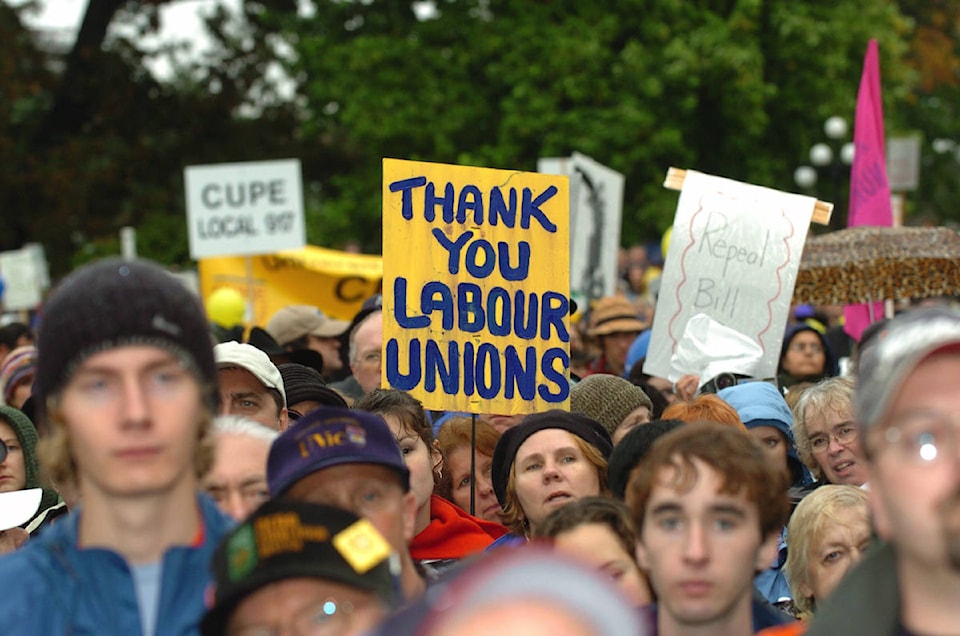Even for a former labour reporter with 16 years reporting on labour disputes, writing a comprehensive history of the BC labour movement was an educational experience.
ŌĆ£I learned stuff doing it, I really did,ŌĆØ said Rod Mickleburgh, author of ŌĆ£On the Line, A History of the British Columbia Labour MovementŌĆØ which is scheduled to be published by Harbour Publishing on April 28.
Mickleburgh, a former labour reporter for the Vancouver Sun and Province newspapers and a former senior writer for the Globe and Mail, was fascinated to learn the prominent role First Nations people played in the early labour history of the province.
ŌĆ£It was a surprise to me,ŌĆØ Mickleburgh said.
The books describes how indigenous people worked on the docks and in fishing, logging and mining, working during the summer and returning to their communities in the winter.
The book quotes the opinion of historian John Lutz, who said ŌĆ£coal would not have been mined in the 1840s and 1850s (without indigenous workers), sawmills would have been unable to function in the 1860s and 1870s, and canneries would have had neither fishing fleet nor fish processors.ŌĆØ
Then, the colonial governments began to methodically force them out.
People who had been trapping in a particular area for generations would show up on their trapline one day and discover that someone else had been given a licence, Mickleburgh said.
Indigenous fishermen saw non-natives take over the fishing industry.
ŌĆ£In every industry where aboriginal people had once laboured productively, they found themselves squeezed by new government restrictions on their hunting, fishing and trapping rights, and the desire by employers for year-round workers coupled with growing mechanization,ŌĆØ Mickleburgh writes.
The other surprise for Mickleburgh was the the fact that workplace safety is still such a problem.
ŌĆ£Tragedies are still going on in the workplace and I find that shocking,ŌĆÖ Mickleburgh said.
The book describes the fatal consequences of lax safety standards at a Langley mushroom farm in 2008, when two workers struggling to clear a clogged pipe in an enclosed pumphouse were rendered unconscious by toxic gases.
When three fellow workers rushed to rescue them, they too were overcome.
ŌĆ£With three deaths and two other victims unable to function, 13 children were left to grow up without their fathers or their active presence,ŌĆØ Mickleburgh wrote.
ŌĆ£The mushroom farm was run as if safety regulations and legalities did not exist.ŌĆØ
A coronerŌĆÖs inquest ŌĆ£detailed a long history of missteps, failures, ignored warning signs and lack of concern by the operators for the basics of health and safety that culminated that fateful September day.ŌĆØ
The deaths at the Langley farm came several years after what Mickleburgh describes as a ŌĆ£heroicŌĆØ but unsuccessful campaign to organize farm workers that saw another Langley mushroom farm unionized , then decertified three years later.
Mickleburgh said the history of the labour movement in B.C. is a history of gains won, then eroded.
ŌĆ£The employers never stop trying to roll back conditions if they can.ŌĆØ Mickleburgh said.
ŌĆ£ItŌĆÖs always under attack.ŌĆØ
Many of the benefits workers enjoy, like eight-hour days, weekends, overtime pay, sick leave, unemployment insurance and the minimum wage were not the result of ŌĆ£benevolent employers,ŌĆØ but were won by workers in unions, Mickleburgh said.
ŌĆ£You just have to take your hat off to them,ŌĆØ he said.
ŌĆ£Why arenŌĆÖt there (more) streets named after labour leaders?ŌĆØ
Mickleburgh said itŌĆÖs been about 50 years since the last comprehensive history of the labour movement was written and published.
His book, he said, is not an academic history.
ŌĆ£I tried to tell a story to make the narrative come alive.ŌĆØ
A major challenge, he said, was keeping the book to a manageable length given the amount of material, which includes more than 200 archival photographs.
The book concludes by noting that after ŌĆ£more than 150 years of struggle marked by death, hardship, sacrifice, many bitter defeats and eventually a long period of solid gains and achievementsŌĆØ the percentage of B.C residents belonging to unions has fallen, especially in the private sector.
According to Statistics Canada, B.C. experienced a six-point decrease in the percentage of workers belonging to a union between 1996 and 2013, the biggest drop in Canada.
Despite that, Mickleburgh writes, ŌĆ£there is no sign of trade unions becoming extinct. They remain a key force protecting and advancing the cause of all workers in a no-holds-barred economy.ŌĆØ
The book was commissioned by the with sponsorship by the , which was originally formed by members of the International Woodworkers of America union.
dan.ferguson@langleytimes.com
Like us on and follow us on





